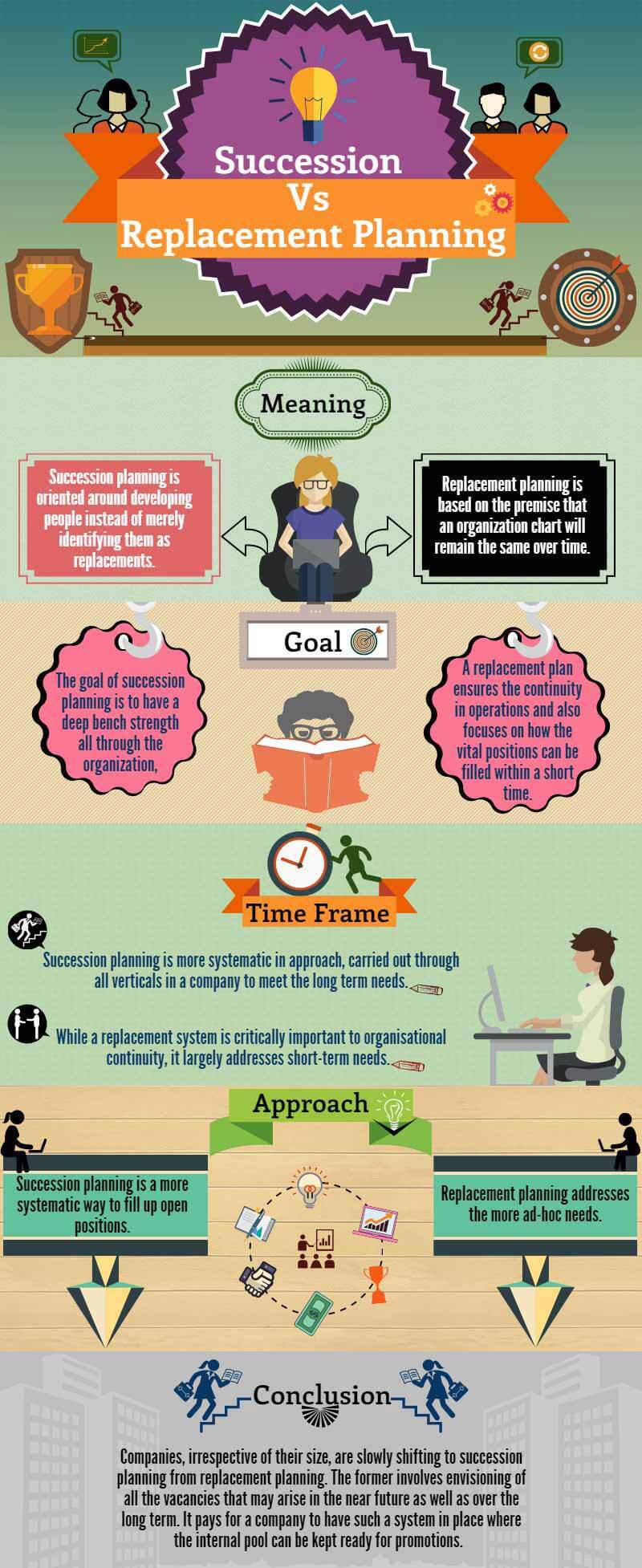Updated June 7, 2023
Succession Planning vs Replacement Planning
Ask the CEO of a company to define succession planning, and there’s a good chance that he/she will confuse it with replacement planning. But the fact is, they are different from each other.
Replacement planning assumes that the organization chart will remain unchanged over time and focuses on identifying “backups” for top positions within the company. The organization chart lists the backups for each top-level position, indicating their readiness to take over the role of the current incumbent. Typically, the organization identifies three individuals as backups for each top-level position.
In contrast, succession planning centers around developing individuals instead of merely identifying replacements. Succession planning aims to cultivate a deep bench strength throughout the organization, ensuring that qualified candidates within the company can be considered for advancement whenever a position becomes vacant.
The top management in most leading companies has realized that it’s wiser to go beyond the traditional tenets of replacement planning and focus on succession planning. This helps to build the long-term viability and sustainability of the organization.
Head-to-Head Comparison Between Succession Planning vs Replacement Planning (Infographics)
Following are some of the comparisons between Succession Planning vs Replacement Planning.
Replacement Planning
All replacement planning activities are tactical in nature. But they are crucial for all organizations, regardless of their size. A replacement plan ensures continuity in operations and focuses on how vital positions can be filled quickly.
- All companies must have a replacement plan for all key positions and other single contributor roles to reduce talent risks.
- Create a replacement plan with one to three identified individuals for key positions in case of emergencies. It must indicate each personnel’s readiness for assuming the role.
- Include appropriate support measures for the person assuming the key role in the replacement plan.
In most companies, replacements are generally perceived as a temporary measure. A replacement candidate may or may not be considered a permanent final contender for the position unless he/she meets all the requirements. While a replacement system is crucial for ensuring organizational continuity, it primarily focuses on short-term needs.
Indications of Succession Planning
Several symptoms indicate the time has arrived to initiate a succession planning system in the organization. Succession planning is a more systematic approach that can be carried out through all verticals in a company.
Some of the common symptoms are as follows.
- The organization conducted a retention risk analysis to estimate the projected departure dates for each person in the workforce or workgroup. This analysis helps identify potential reasons for departure, such as retirement or other factors.
- If the organization experiences a sudden loss of key talent due to death, resignation, or disability, it may take a long time to find an appropriate replacement. The organization cannot respond promptly to such surprises.
- Senior managers may lack awareness or perceive the time taken to fill vacant positions, known as the time-to-fill metric, as lengthy.
- Managers at various levels may complain about finding people ready for promotion or willing to accept a promotion when a vacancy arises.
- Staff members often express concerns that promotion decisions are made in an arbitrary or unfair manner.
- The company may not adequately represent women employees, minorities, and other groups protected by law across all organizational levels and functions.
- Critical turnover refers to the number of high-potential workers leaving the organization, which is higher than average workers.
Scope
There are three reasons to devise a succession plan in an organization. Identifying the replacement for a CEO or other top managers is only a part of the reasons. The reasons are as under.
- Replacement of key employees
- Supporting anticipated growth
- Addressing and dealing with a talent shortage
Unfortunately, many organizations see succession planning as a task to be checked off and set aside, relegating it to other responsibilities. They see it as a means to an end and often perceive it as solely the responsibility of human resources. However, this is the wrong mindset to have. Succession planning should be seen as a talent and organizational improvement initiative that enables a business to thrive and grow. No matter what industry or sector a company operates in, it cannot grow or succeed without strong management talent. Developing, nurturing, and grooming the talent pipeline is not a simple task but essential for any organization’s long-term success and sustainability.
We have finally emerged from the worst economic downfall since the Great Depression. Yes, the succession rate of unemployment is still high in most countries, which makes many managers believe that there’s a strong talent pipeline. Whenever an executive or management resource, all they need to do is pick up the phone, post an advertisement on a popular job site like CareerBuilder or Monster, and voila, their talent requirement will be resolved. Heads up: several of your industry peers are seriously contemplating poising themselves for growth and hope you continue with your belief.
Whether bad or good economic situation, proper talent is hard to get because talent is a combination of behaviors, skills, organizational fit, motivation, and passion. That’s especially difficult to find if you have to hire fast.
Let’s detail the three reasons for putting in place a succession plan.
-
Replacement of Key Employees
Most companies tend to believe that the only reason to implement a succession plan is to pick a replacement for the departing CEO or perhaps a couple of top-level executives. This is a major reason for a succession plan. But a complete reason is to identify proper replacements and, in the process, prepare to fill all major positions in the company and not just the CEO or top executives. This is often called “planning many levels deep”, i.e., mid-level executives to section managers and division. Succession planning includes all necessary roles to keep the business moving, even if unobvious. Keep in mind that while executives set the strategy, managers implement them. A company must have strength in both areas to succeed.
Managers and executives will leave a company. They may take up another job in a different organization or be axed. They may retire, become terminally ill, or leave town because of a spouse’s relocation. Whenever a company anticipates a vacancy of a manager or executive, a seamless transition can be possible simply because there’s time for taking care of the transition. It’s when the vacancy is unexpected that the challenge crops up. Maintaining continuity is important because it reduces service disruptions and costs. As the economy improves, growth will take place. A company can support and sustain growth only when it has a talent for managing growth.
-
Supporting Anticipated Growth
This strategy differs from a replacement strategy as it involves creating new positions to support growth initiatives. These positions may be required to expand current products and services into new markets, develop and introduce new products and services, and devise innovative selling methods such as viral marketing.
While identifying growth areas, identify the internal talent and set up and maintain a talent database comprising candidates currently working for other companies.
-
Addressing and Dealing with a Talent Shortage
Even during an economic downturn, a company may face a talent shortage for critical positions such as nurse managers, sales representatives, pharmacy managers, engineers, and other professionals. For instance, studies have shown that finding a replacement for a resigned pharmacy manager in a hospital can be extremely challenging. In such situations, the company may feel compelled to promote personnel before being fully prepared for the position, but this should only be considered a last resort. To avoid a lengthy leadership void, it is crucial to have a plan in place for selecting suitable candidates and supporting their transition well in advance. Kneejerk placements and rushed hires are unlikely to yield desirable outcomes.
In all organizations, succession planning is not an event but a process. Succession planning is a process that’s critical for all organizations, whether they are expecting vacancies and turnover, working to cope with a talent shortage, or planning for growth.
To address issues of talent shortage, the following steps are recommended.
- Assign the responsibility of succession planning to executive team members. Make the activity a part of their evaluation process.
- Identify critical needs and key roles for the present and future, several layers deep.
- Come up with and use tools, techniques, and methods to identify employee aspirations and competencies.
- Put in place a structure to develop potential successors.
- Implement a structure to transition the successors to and in the new roles.
- Identify an interim or emergency process to fill up a vacant position if, for whatever reason, the identified successor doesn’t work out.
- Align recruitment initiatives for succession planning by predicting the core needs and interviewing for adaptability and growth orientation.
- Evaluate all plan effectiveness and update plans as required, at least annually.
Succession Planning vs Replacement Planning- Talent pools
One approach to resolving staff-filling problems could be to develop a talent pool. It’s a group of people prepared to take up more challenging responsibilities.
People in a talent pool can be drafted in several ways. One popular approach is to ask managers to assess and nominate people from their teams. A second approach could be to apply an objective assessment method, like multi-rater full-circle tests, for identifying personnel who could be worthwhile to take up future responsibilities.
A talent pool dramatizes the difference between succession and replacement planning. Personnel is identified as “backups” to specific positions in the latter.
Replacement planning encourages promotions only in a field of specialization. On the other hand, succession planning encourages managers across all verticals to consider talent, irrespective of the department, as a possible successor to all positions immediately above them. Talent pools, thus, can be identified beneath every “level” of the organization chart. However, they aren’t tied to any specific position at the immediately following level.
If the talent pool implementation succeeds, the company will have multiple internal candidates ready and equipped to take up new challenges and responsibilities.
Conclusion
Both replacement and succession planning are important for any company. But while succession planning is a more systematic way to fill open positions, replacement planning addresses the more ad-hoc needs. Building up a talent pool is the most important part of replacement planning, where there are many to choose from. But at the same time, a temporary or non-permanent filling up can be of a long-term nature. However, that happens only by chance. A company is unlikely to ask a person to vacate the position after he/she has been appointed to it.
Companies, irrespective of their size, are slowly shifting to succession planning from replacement planning. The former involves envisioning all the vacancies that may arise in the future and over the long term. It pays for a company to have such a system where the internal pool can be kept ready for promotions.
Recommended Articles
This has been a guide to Succession Planning vs Replacement Planning. Here we have discussed the basic concept, head-to-head comparison, and infographics. You may look at the following articles to learn more –







